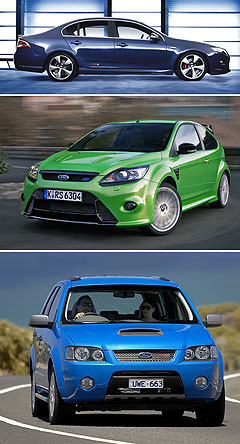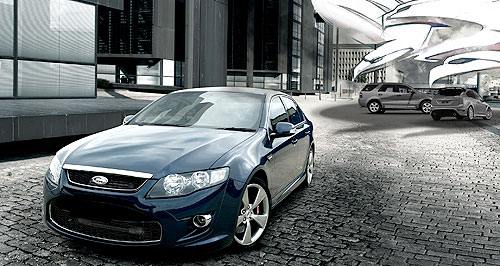Future models - FPVFPV confirms new V8 for 2010Fresh range: FPV is preparing a new range of Falcon-based models for launch with new powertrains in mid 2010. Ford’s alloy ‘Coyote’ V8 set to ignite ‘fast Falcon’ FPV next year25 Aug 2009 FORD Performance Vehicles (FPV) will go back to basics with an all-Falcon-based performance-car range powered by an all-new V8 engine and a heavily revised version of the Australian-bred inline turbo six when an upgraded series arrives in July next year. The company this week confirmed that it had killed plans for an FPV-badged, high-performance version of the Ford Focus after Ford Australia reversed its decision to build the small car locally from 2011. It also ruled out another SUV experiment with an FPV version of the turbocharged Ford Territory after the F6X failed to ignite customer passions and was recently discontinued. FPV general manager Rod Barrett summed up the company’s direction by saying: “We are into building fast Falcons.” Mr Barrett confirmed that a new V8 was in the pipeline to replace the current Boss 5.4-litre engine for the facelifted range from mid-2010. He declined to confirm details of the new engine and would not be drawn on speculation that it would be taken from Ford’s new high-performance V8 program being developed under the ‘Coyote’ codename for a range of Ford’s US models, including the Mustang. “It won’t be the same engine (as the current Boss 5.4),” he said. “But that’s all we are saying about it.”  From top: The FPV F6 E, Ford Focus RS and FPV F6X. From top: The FPV F6 E, Ford Focus RS and FPV F6X.The 2011 Mustang’s 5.0-litre version of the double overhead camshaft all-alloy Coyote V8 is said to develop 298kW of power and 542Nm of torque, but larger iterations – up to 5.8 litres with up to 335kW of power – are reported to be under development. FPV’s current Boss V8 develops 315kW of power at 6500rpm and 551Nm of torque at 4750rpm. But this locally assembled engine will not meet the stricter new emissions regulations that become mandatory from July 1, 2010, and falls short of HSV’s revised LS3 6.2-litre V8, which from next month will punch out at least 320kW in the facelifted E Series 2, which was revealed to HSV dealers in Melbourne this week and will be publicly revealed next month. Mr Barrett was at pains to point out that powertrain development for the next FPV range included both six-cylinder and V8 engines, with emphasis on meeting the new Euro IV emissions restrictions while pursuing performance targets. He confirmed that the six-cylinder engine would be Australian – a reworking of the current inline six reprieved recently when Ford had a change of heart and decided to keep it in production at Geelong for the foreseeable future. The new range will get exterior body changes, but not a wholesale makeover. “It will be evolution, not revolution, for us next year,” Mr Barrett said. “It’s no secret that we need to change the aesthetics of our car – it has been a few years since we did so.” But buyers should not expect dramatic aerodynamic aids, with Mr Barrett hinting that prominent wings would be out. He pointed to the success of FPV’s new, more subtle entries such as the executive-express F6 E and GT E as evidence of performance-car customer trends. Mr Barrett poured cold water on speculation that a new-generation GTHO was in the pipeline, saying it remained his personal dream, not a reality. “We are not prepared to even think about it until we have all the hardware, all the finance and everything else we need in place to do it properly,” he said. “We would never do it as a limited-edition, as that would never do it justice.” However, Mr Barrett did not rule it out completely, saying: “I would love to do it in 2011 because that would be the 40th anniversary of when Allan Moffat won Bathurst in one.” Mr Barrett said that with respect to any GTHO program, he had been a “keen spectator” of rival HSV’s $155,500 7.0-litre 427 flagship, which fell short of sales expectations, selling 137 units. “I would hate to think we were putting a car as expensive as that on the market,” he said. “A GTHO would have to be an Aussie car for Aussie buyers.” Mr Barrett said an FPV version of the Focus was off the agenda after Ford cancelled local production plans for the global small car. He said modifying imported cars was unprofitable for FPV, so no four-cylinder FPV Focus would be forthcoming. Mr Barrett said his company had toyed with the idea of bringing in the German-built Ford Focus RS (Rallye Sport), which in Europe is a turbocharged competitor for hot hatches such as the Civic Type R and Vauxhall Astra VXR, which is imported into Australia in small numbers by HSV. But Mr Barrett said the business case did not stack up, and the project had never been seriously pursued. “So we are going straight down the Falcon line now,” he said. Despite the development of a new direct-injection LPG E-Gas Falcon for launch in 2010, Mr Barrett ruled out following HSV into alternative fuels in the short term, but said such options would be considered in future. He also said FPV would keep its powder dry on any response to HSV’s new E2 range until FPV launched its 2010 models in July next year. He said the forthcoming limited-edition FPV GS had not been designed as “an HSV fighter” and, even though the launch timing was the same, it was coincidental. Details of the GS were revealed on the internet by an over-enthusiastic dealer after a special preview recently, causing some pain for FPV but also causing a rush of buyer enquiry. Ford has denied the GS is a long-term replacement for Ford’s Falcon XR8, but it seems to have left the door open for such a move in future if Ford decides to drop V8s from its regular line-up and leave the market to FPV. Ford Australia communications manager Sinead McAlary said the GS had been designed only as an FPV limited-edition, and that it was too early to discuss future model strategy. FPV will be hoping for a sales fillip from the special edition to help it towards its sales target of just under 2000 units this year – down just three per cent on last year’s 2085 units – but only about half the volume of HSV. However, Mr Barrett said 2009 had not turned out as bad as feared when his company was going over its sales projections at the end of the last year. “If someone had told me back then that we would do close to 2000 cars this year I would have jumped for joy,” he said. Mr Barrett said the growing success of the force-fed six-cylinder F6 had been responsible for helping sustain FPV sales in a depressed car market, and it now accounted for almost a third of FPV sales. The overall sales split between six-cylinder and V8 powertrains at FPV is now about 60/40 in favour of the V8, but the gap is currently closing. FPV recently extended its six-cylinder reach with the addition of the $79,740 F6 E, a more luxurious, more subtle version of the turbo sedan, aimed at the executive market. He said the federal government’s 50 per cent tax break for business purchases had also helped to drive up FPV ute sales.  Read more4th of August 2009  FPV extends F6 appealFord Performance Vehicles finally turns its turbo-luxury F6 E concept into reality27th of July 2009  Ford Falcon EcoBoostedFalcon to plug in to global Ford plan with direct-injection 2.0-litre EcoBoost15th of June 2009  Ford to decide Falcon engine futureDeadline looms for Ford’s Australian-made six-cylinder engineAll future models Alfa Romeo Alfa Romeo Abarth Abarth Audi Audi Aston Martin Aston Martin BMW BMW Bentley Bentley Chrysler Chrysler Chevrolet Chevrolet Dodge Dodge Citroen Citroen Ferrari Ferrari DS DS Ford Ford Fiat Fiat FPV FPV Foton Foton Haval Haval Great Wall Great Wall Honda Honda Holden Holden Hyundai Hyundai HSV HSV Isuzu Isuzu Infiniti Infiniti Jeep Jeep Jaguar Jaguar Lamborghini Lamborghini Kia Kia Lexus Lexus Land Rover Land Rover Mazda Mazda Maserati Maserati Mercedes-Benz Mercedes-Benz McLaren McLaren Mini Mini Nissan Nissan Mitsubishi Mitsubishi Peugeot Peugeot Opel Opel Proton Proton Porsche Porsche Renault Renault Ram Ram Saab Saab Rolls-Royce Rolls-Royce Smart Smart Skoda Skoda Subaru Subaru SsangYong SsangYong Tesla Tesla Suzuki Suzuki Toyota Toyota Volvo VolvoMotor industry news |
Click to shareFPV modelsAll future models Alfa Romeo Alfa Romeo Abarth Abarth Audi Audi Aston Martin Aston Martin BMW BMW Bentley Bentley Chrysler Chrysler Chevrolet Chevrolet Dodge Dodge Citroen Citroen Ferrari Ferrari DS DS Ford Ford Fiat Fiat FPV FPV Foton Foton Haval Haval Great Wall Great Wall Honda Honda Holden Holden Hyundai Hyundai HSV HSV Isuzu Isuzu Infiniti Infiniti Jeep Jeep Jaguar Jaguar Lamborghini Lamborghini Kia Kia Lexus Lexus Land Rover Land Rover Mazda Mazda Maserati Maserati Mercedes-Benz Mercedes-Benz McLaren McLaren Mini Mini Nissan Nissan Mitsubishi Mitsubishi Peugeot Peugeot Opel Opel Proton Proton Porsche Porsche Renault Renault Ram Ram Saab Saab Rolls-Royce Rolls-Royce Smart Smart Skoda Skoda Subaru Subaru SsangYong SsangYong Tesla Tesla Suzuki Suzuki Toyota Toyota Volvo VolvoMotor industry news |
















Facebook Twitter Instagram